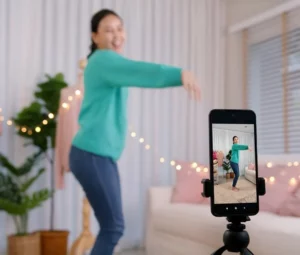Trending Today
Get the Tips: Marketing
for 7-Figure Growth
for 7-Figure Growth
Get solid marketing strategies, designed for entrepreneurs on the track to 7-figures and beyond, right in your inbox.

While TikTok may be a social media platform, I’m going to explain why it works more like paid (PPC) advertising in the fact that when you stop doing it, you also stop getting results. And why you need to also start thinking about it the same way.
TikTok is a social media platform that requires a lot of commitment. You have to constantly be creating new content, engaging with other users, and promoting your brand. If you stop doing any of these things, you will stop getting results.
This ongoing commitment on TikTok of your time resources isn’t the same as other organic and social strategies that tend to keep producing results long after the content has been shared.
Entrepreneurs need to consider this and treat TikTok more like a paid media platform, being wise of the amount of time and effort required long-term to maintain results.
Before you think I’m crazy … I realize this may be your first time here, or you’ve never been introduced to my experience. I’ve been doing marketing for 30 years, a former (and currently Fractional) CMO, working with Fortune 500 companies, multi billion dollar organizations, now focusing on entrepreneurs.
I test every platform early and begin using them for marketing long before most people are even signed up. And I work with thousands of entrepreneurs who use them every day. I have some hard-earned insights to share with you.
One of the great functions of organic marketing strategies – and I’m lumping social media in this since there is overlap – is that they continue to provide awareness, engagement, traffic back to your website, and whole host of other microconversions that help our business become successful over time, and usually long after the initial time investment has passed.
That’s why organic marketing such an effective strategy, and one of the pillars of the types of media that can be used in your marketing strategy.
I remind you that the most effective marketing relies upon all four pillars of media – organic, shared, paid, and earned media. Any business that relies upon only one or two simply won’t have the same long-term, sustainable success as those that incorporate all four; although not necessarily all four all day every day, but they do need to each be part of a strategic and integrated marketing plan.
 Paid Media Requires Money
Paid Media Requires MoneyPaid media is the one (the only one) out these marketing media pillars that you have to keep throwing resources at to keep getting the results. Usually that resource is money … a direct expense. Once you stop expending the resource (stop paying for the ads), you no longer see the results. Makes sense, right?
For shared media, which is functionally part of organic media strategies (but I include it as it’s own pillar since you don’t own the platform that it’s hosted on), there is still a resource required: time.
When strategized well, this time can be optimized to be super efficient, or can even be outsourced relatively easily to a team (like our team of social media strategists).
So while time is still required, it’s not restricted to being your personal time. And as entrepreneurs our personal time is one of our most precious resources.
I always hammer home the fact that your zone of genius almost always does, and needs to, be focused on a different area of your business than your marketing. Your time is best expended in those areas of the business that ONLY you can do.
We’re going to walk through a bit of math here, because I find that too many entrepreneurs don’t factor in all of the expenses that they should.
I know I know, you didn’t think you were attending math class today. But if you really hate math, you may want to scroll to the next section which explains why this is so critical for your business. (If you’re concerned or curious if you might be missing some of the expenses that need to be factored, then you need this section.)
Take your hourly rate, and multiply that by the total yours you spend monthly personally doing whatever marketing strategy, such as social media or TikTok. (Don’t have your hourly rate in your mind yet? A quick calculation is take what you want to make a year, multiply by 2, and divide that by 2000. Much more goes into this, but that will get you a quick number.)
You must also account in your hours for the time that you’re using brainpower to think and plan and strategize, the time to create the content or video plus any editing, the actual posting to the platform, plus any follow up.
So, get out your calculators or sharpen your pencils. I’ll make it easy for you.

Let’s work with some nice round numbers for an example entrepreneur who is spending time marketing on TikTok – although this same concept applies to any platform.
Say your hourly rate is $100 an hour, and you spend 10 hours a month on social media, that’s an equivalent expense of $1,000 for your business.
$100/hr X 10 hrs = $1,000
However, in this case, your focus time as the business owner is a double whammy. Not only are you spending those 10 hours focused on social media, but at the same time you are taking 10 hours away from those business tasks that only you can perform.
So the effect on your bottom line is actually double (if not triple or more!) – for our example $2,000.
$100/hr X 10 hrs x 2 = $2,000
Most entrepreneurs mistakenly consider any marketing that they are personally handling as free work since they didn’t have to pay for it, and therefore any leads and eventual sales are all found money! Woohoo!
$0/hr X 10 hrs = $0
So the work is done, you put in 10 hours this month.
Let’s say you got 100 leads (real, valid leads, and not just the curiosity tire kickers) from that time you invested.
A lead is someone who has completed a microconversion – signed up on a form on your website, signed up for newsletter, requested a download or trial – but have not made a purchase.
You may be thinking that’s zero cost per lead … how excellent!
100 leads x $0 = $0 cost per lead
But in reality, since you MUST expense for your time, you’re actually looking at a cost per lead of $20.
And you may be okay with that number depending upon the cost of your product or service.
100 leads / $2,000 cost of time = $20 cost per lead
Across the board, average for all industries, a good conversion rate (turning the lead into the sale) is 10-15%. I’m going to go high here and go with 15% – although you could find that your conversion rate is as low as 2%. It may just depend upon your product or service, the length of your sales cycle, and so many other things.
100 leads x 15% conversion rate = 15 sales (conversions)
That now puts the cost of each sale, when using the value of your time, at $133. (Keep in mind, if you have a lower conversion rate, that number will be higher per sale).
$2,000 cost of time / 15 sales = $133.33 cost per sale
That maybe seems okay, right?
Here’s where we cannot tell you if that number looks good or not, because you have to now factor in the cost of your product or service.
When you include the cost of your product, we can determine the sales ratio.
A lower sales ratio means a higher profit. For round numbers, let’s use $250 as the cost of the product or service, and we find that we have a 53% sales ratio.
($133 per sale / $250 retail price) / 100 = 53% sales ratio
If you don’t like working with percentages, you can also simply look at the net amount after deducting the value of your time:
$250 retail price = $133 cost per sale = $117 net
If you’re like most businesses, there’s a lot that goes into your $250 product or service.
Manufacturing costs which all roll into your Cost of Goods Sold. Ongoing expenses like office rent, or website design or hosting. Phone and internet service. Printing costs. Accounting and banking costs. The list goes on and on and on, as I’m sure you know.
This is why the general rule of thumb is that your expenses should run around no more than 50-60% of your retail price. If you’ve ever watched the TV show “The Profit”, Marcus walks through this percentage in almost every episode.
Did you notice …
Our cost of sale / sales ratio above is already at 53%.
That means the wholesale cost of our product or service has already hit 53% without us considering any of the other expenses involved.
If your other expenses are already running at, say 40% – which would normally provide you with a good markup margin – and you add the 53% cost of sales on top of that … you’re only left with a 7% profit.
40% cost of goods sold + 53% cost of sales = 93% wholesale expenses
Now think of all of your personal time that goes into each individual product or service. For your personal salary to be $100 per hour, you would need to sell 15 items. Every hour. Or at least every hour that you want to make $100 – so maybe Mon-Fri 8-5.
$100 per hour / $7 profit per item = 14.2 items per hour
Now, in some cases, that 7% may be perfectly acceptable, if your goal is to attract clients that you have a good track record of upselling in the future. In some cases, even taking a loss on an entry-level product or service can work out for your business in the long term. But these strategies need to be done purposefully and not accidentally.
However … if your $250 product or service is your ONLY product or service, and you’re spending this much of the value of the resource of your time (in this case $2,000) to bring in this level of leads (in this case 100) … then, despite how well your results appear at first glance to be on the platform you’re using … it may be a waste of your time.
If this is the ONLY source of your leads, then you need to:
When you’re serving as the face of your business – as most entrepreneurs are – it’s not so easy to outsource TikTok because of nature of the platform: video. In almost all cases, it is – and needs to be – a video of your face.
If you’re the face showing up on TikTok, then you need to continue to be the face showing up on TikTok. Because like we already said above, when the work stops, so does the results.
There are, however, a few ways around this:
We work with a lot of entrepreneurs who are focused to growing their business to 7-figures (million dollars annually) and beyond, even experienced with growing billion-dollar companies.
In 100% of these cases, unless the entire business revolves around you being an influencer who gets paid to share sponsored content, you MUST get to the point of outsourcing your marketing. You can’t still be the one being the face of your TikTok unless your entire business model is being an influencer.
 Because of this required commitment of your time resources, as TikTok continues to grow in popularity, entrepreneurs need to approach it more like a paid media platform and realize that there will be a larger investment – in this case with time – to maintain the same results.
Because of this required commitment of your time resources, as TikTok continues to grow in popularity, entrepreneurs need to approach it more like a paid media platform and realize that there will be a larger investment – in this case with time – to maintain the same results.
The nature of the platform means it cannot be approached in the same way as other shared media, and that needs to be taken into account when you look at your strategy and the finite time you have available.
While it may be tempting to just post content and hope for the best, treating TikTok like a paid media platform (by realizing that you need to continue to allocate resources) will be more effective in the long run. If you stop, so will your results.
For the majority of our clients, when they have calculated the numbers like we did in our scenario above and looked at the true cost of their time spent on TikTok, plus looked at the requirement of continuing to invest their time on the platform, they’ve chosen to drop TikTok as a primary focus. They may still use the platform, but it’s no longer their main choice.
For those clients who have chosen to keep TikTok as a strategy, they’ve still realized that their personal time is best spent elsewhere, and turned TikTok over to an agency.
If you’ve made it down this far and through all that math I threw at you, I’m curious to know:
Have you ever calculated the value of your time spent on TikTok against the profit value of the sales that you’ve made?

Vicky is the CEO and Chief Creative Strategist of Vicky Wu Marketing. She draws from 30 years of experience at the CMO level, the CEO level, marketing for Fortune 500 companies and multi-million and multi-billion-dollar organizations, PLUS strategies learned helping startups and nonprofits with limited budgets … now focusing on providing SMBs with effective and efficient marketing strategies – giving them access to the same level of expertise as the really big guys with deep pockets, that they may not otherwise be able to access.
Let the pros handle your social media.
Get solid marketing strategies, designed for entrepreneurs on the track to 7-figures and beyond, right in your inbox.

